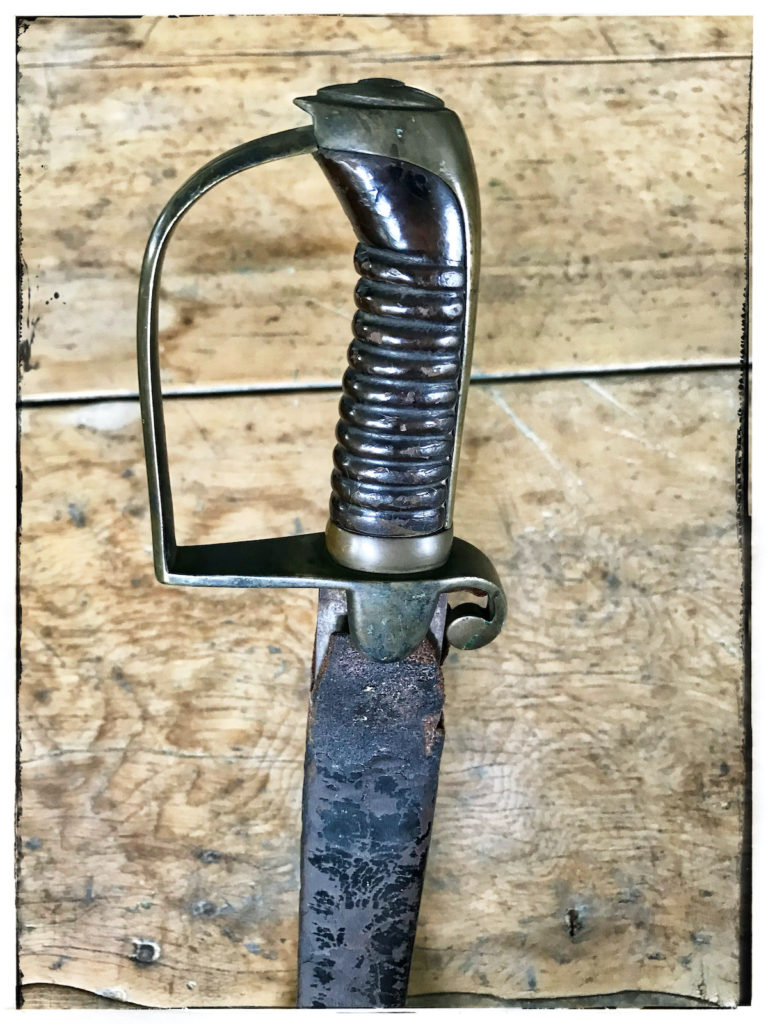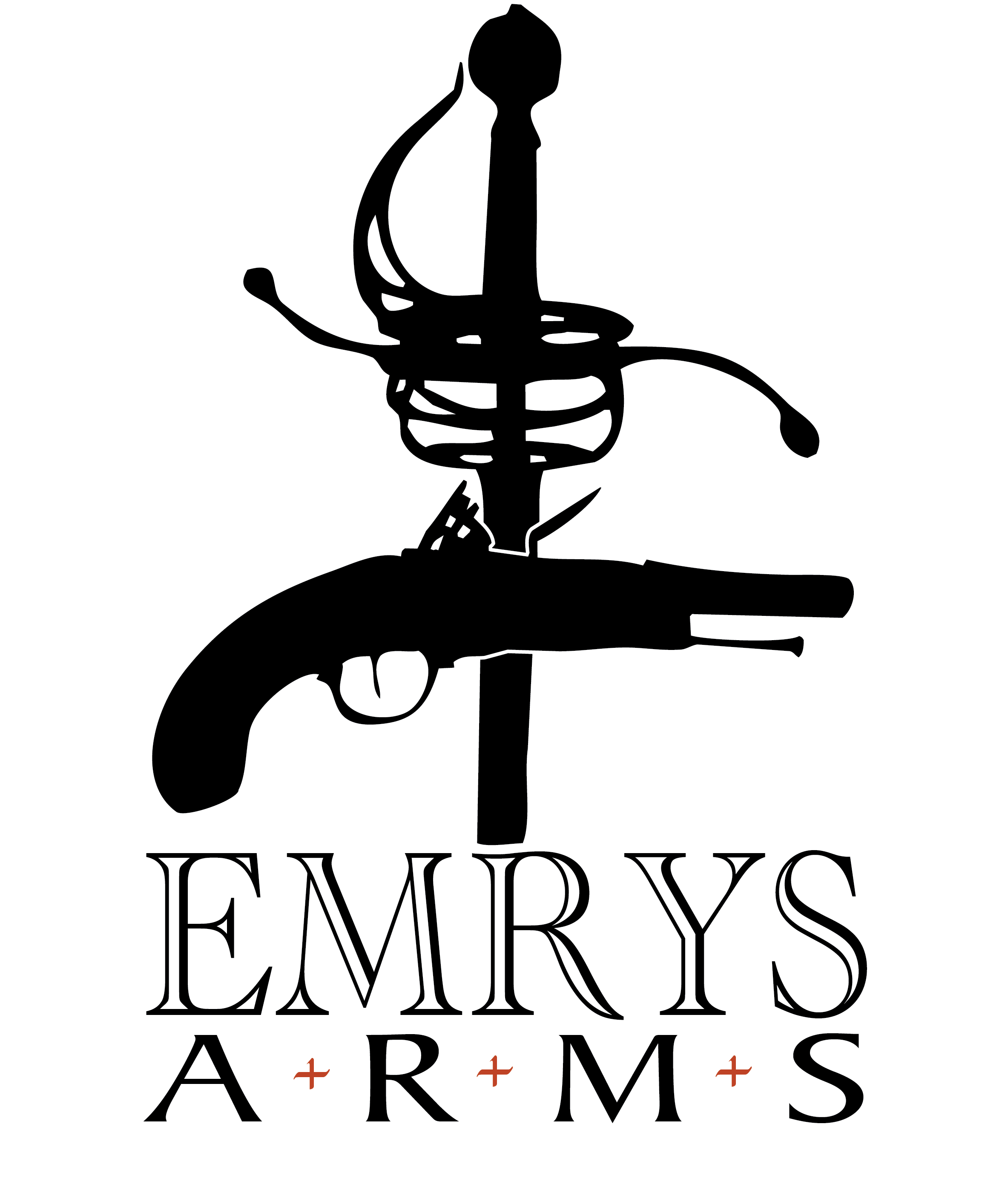| Collection #: | 2020.027 |
|---|---|
| Type: | Foot Artillery |
| Nationality: | British |
| Pattern: | No official pattern - sometimes referred to as the 'Spanish Hanger' |
| Date: | c.1800 |
| Hilt: | Brass |
| Blade Length: | 63.4cm (24.96") |
| Blade Width: | 3.6cm (1.42") |
| Overall Length: | 75.3cm (29.65") |
| Maker: | No maker's mark |

This example is almost identical in every way to 2020.025. The sword measurements are the same; the overall condition is the same with the exception that the fragile scabbard has cracked through on the underside requiring extra attention to support it and prevent further deterioration.
The sword’s current structural stability is solid with no movement in its parts whatsoever. Amazingly, it also retains its scabbard, minus the locket. Compared to sword 2020.024, there are some minor differences. The brass D guard is the same. The beaked pommel is the same. The blade is also the same. The difference comes in the quality of the grip and the lack of any markings on the blade. The grip, on first appearance, seems to be a finely polished wood, but when you look close, there are small areas of cracked leather that you can see. The leather is as hard as wood and almost as though it has been shrink-wrapped right onto the wooden form of the grip. The lack of maker markings and government ownership markings may indicate that this was a private purchase sword. This is supported by the background of the town from which this sword and its identical twin (2020.025), came.
This sword (and 2020.025) came out of an old house in St. Andrews, New Brunswick. St. Andrews, during the lead-up to the War of 1812 was advised to strengthen its defences. The towns’ people came together to build and furnish three block houses (only one remains) over the course of the war – though the town itself never ended up being attacked.
It cannot be proven 100 percent, but it is possible that these two swords (2020.027 and 2020.025) were privately purchased by the town of St. Andrews as part of arming the blockhouses. This would explain the lack of government ownership markings.
There are two aspects of this particular example which are interesting. One, the quillon is quite bent down to almost touch the blade. I would normally presume that this simply happened while in use, but it is interesting to note that its twin (2020.025) is exactly the same. Two, this is a rare opportunity to study the scabbard of the c.1800 foot artillery hanger as they are rarely found with their scabbard. Unfortunately, both this one and its twin are missing their lockets, but both have their chapes. The scabbard on this piece is more delicate, being split on the underside.
This pattern of sword has always been a bit of a mystery in the arms-collecting world. It does not have an official pattern designation. The information that we do have on it is based on paintings produced in the early 1800s and some vague letters or reports, which discuss its use. According to Bryan Robson in his book Swords of the British Army, it is known that as of the 1790s the regular artilleryman was carrying a short-bladed sword with a brass knucklbow in a black scabbard with brass fittings. (Pg.231) This would certainly seem to fit this example. While this sword no longer has its scabbard, swords 2020.025 and 2020.027 are of the same type and do retain their scabbards with a brass chape, their lockets missing.
It is possible that this sword is referred to in a letter from the Select Committee on Artillery in 1819. In this letter, it is referred to as a very inefficient weapon. Another possible reference to it, sometime later, comes from another report from the Select Committee on Artillery Equipment in 1855. In this report, it is referred to as the ‘Spanish pattern hanger’ and amongst some collectors, this is what it is referred to as. “It was to be worn by all gunners and drivers attached to field guns down to 1826.” (Robson, page 231-2). That this is the so-called Spanish hanger is not 100 percent clear from the report, but it is generally accepted that this is indeed the case.
We use cookies to improve your experience on our site. By using our site, you consent to cookies. Enjoy the cookies...they're delicious...
Websites store cookies to enhance functionality and personalise your experience. You can manage your preferences, but blocking some cookies may impact site performance and services.
Essential cookies enable basic functions and are necessary for the proper function of the website.
Statistics cookies collect information anonymously. This information helps us understand how visitors use our website.
Google Analytics is a powerful tool that tracks and analyzes website traffic for informed marketing decisions.
Service URL: policies.google.com

